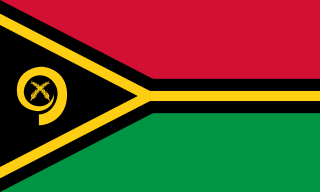
Vanuatu, officially the Republic of Vanuatu, is an island country in Melanesia located in the South Pacific Ocean. The archipelago, which is of volcanic origin, is 1,750 km (1,090 mi) east of northern Australia, 540 km (340 mi) northeast of New Caledonia, east of New Guinea, southeast of Solomon Islands, and west of Fiji.

John Frum is a figure associated with cargo cults on the island of Tanna in Vanuatu. He is often depicted as an American World War II serviceman who will bring wealth and prosperity to the people if they follow him. In a 1960 BBC documentary, British broadcaster David Attenborough asked the locals what Frum looked like and was told "'E look like you. 'E got white face. 'E tall man. 'E live 'long South America."

The Lapita culture is the name given to a Neolithic Austronesian people and their distinct material culture, who settled Island Melanesia via a seaborne migration at around 1600 to 500 BCE. The Lapita people are believed to have originated from the northern Philippines, either directly, via the Mariana Islands, or both. They were notable for their distinctive geometric designs on dentate-stamped pottery, which closely resemble the pottery recovered from the Nagsabaran archaeological site in northern Luzon. The Lapita intermarried with the Papuan populations to various degrees, and are the direct ancestors of the Austronesian peoples of Polynesia, eastern Micronesia, and Island Melanesia.

Museology is the study of museums. It explores the history of museums and their role in society, as well as the activities they engage in, including curating, preservation, public programming, and education.
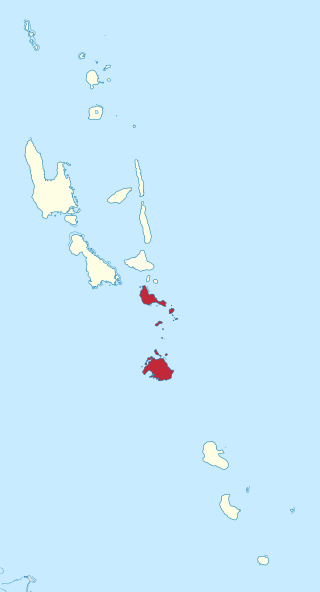
Shefa is one of the six provinces of Vanuatu, located in the center of the country and including the islands of Epi and Efate and the Shepherd Islands. The province's name is derived from the initial letters of SHepherd and EFAte. It has a population of 78,723 people and an area of 1,455 km2. Its capital is Port Vila, which is also the capital of the nation.

Malakula, also spelled Malekula, is the second-largest island in the nation of Vanuatu, formerly the New Hebrides, in Melanesia, a region of the Pacific Ocean.

Ni-Vanuatu is a large group of closely related Melanesian ethnic groups native to the island country of Vanuatu. As such, ni-Vanuatu are a mixed ethnolinguistic group with a shared ethnogenesis that speak a multitude of languages.

Erromango is the fourth largest island in the Vanuatu archipelago. With a land area of 891.9 square kilometres (344.4 sq mi), it is the largest island in Tafea Province, the southernmost of Vanuatu's six administrative regions.

The Museum of Archaeology and Anthropology, also known as MAA, at the University of Cambridge houses the university's collections of local antiquities, together with archaeological and ethnographic artefacts from around the world. The museum is located on the university's Downing Site, on the corner of Downing Street and Tennis Court Road. In 2013 it reopened following a major refurbishment of the exhibition galleries, with a new public entrance directly on to Downing Street.
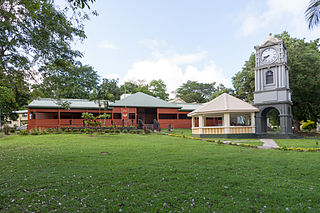
The Fiji Museum is a museum in Suva, Fiji, located in the capital city's botanical gardens, Thurston Gardens.

Christianity is the largest religion in Vanuatu. Vanuatu is an archipelago made up of 13 larger islands, and approximately 70 smaller surrounding islands, each home to multitudes of diverse cultural and religious communities.
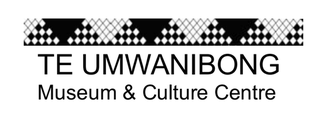
Te Umanibong or the Kiribati Cultural Museum, or Kiribati Museum and Cultural Centre, is a museum in Bikenibeu on the atoll of Tarawa in Kiribati. It displays artefacts and other items of cultural and historic significance.

This article presents an overview of the culture of Vanuatu.

The Vanuatu Cultural Centre, founded in 1955, is the national cultural institution of Vanuatu. It is located in the capital Port Vila.
Nicolai Michoutouchkine, a Russian from Vanuatu, was a painter, artist, designer, and collector of Pacific artifacts.
Lissant Mary Bolton is an Australian anthropologist and the Keeper of the Department of Africa, Oceania and the Americas at the British Museum. She is particularly known for her work on Vanuatu, textiles, and museums and indigenous communities.
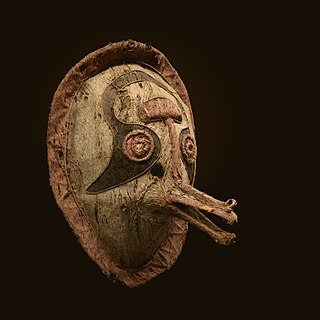
Eharo masks were a type of mask used by the Elema people of the eastern Gulf of Papua as part of the "hevehe" cycle of masked rituals. These masks were crafted from barkcloth, vegetable fiber, and various pigments.
Janet Fieldhouse is a Meriam Mir ceramic artist based in Cairns, Queensland, Australia. Fieldhouse uses a variety of clays and ceramic techniques to recover, reinterpret and represent Ailan Kastom: the cultural practices, symbols and artistic traditions of her Erub community, particularly the significant roles and contributions of women. Fieldhouse was introduced to ceramics by artist and Thainakuith elder, Thancoupie Gloria Fletcher James. Since then, Fieldhouse has developed her practice through artist residencies in Japan and the United States and a Master of Philosophy at the Australian National University in 2010.

The Solomon Islands National Museum is the national museum of the Solomon Islands and is located in Honiara. It is a department of the Ministry of Culture and Tourism.
Nadia Kanegai is a social entrepreneur, politician and historian from Vanuatu. She made the first study of women's traditional tattooing on Ambae. She has stood as a candidate in three elections in Vanuatu and was a prominent community activist during the 2017 and 2018 eruptions of Manaro Voui.























